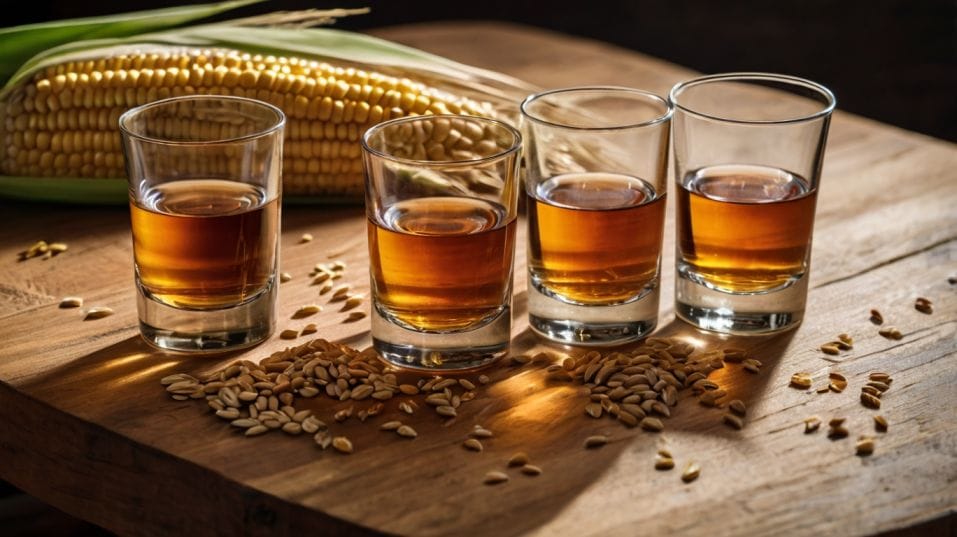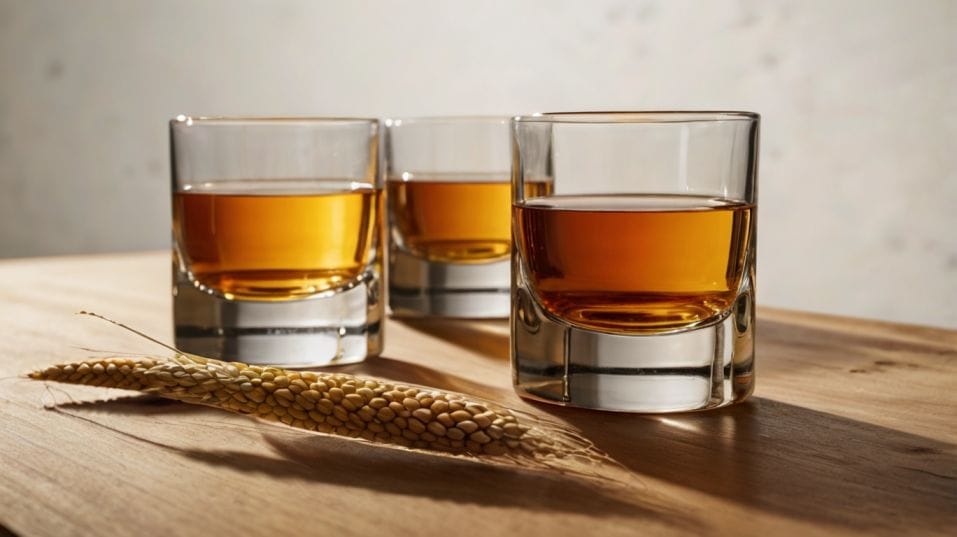A Flavor Map of the Whiskey World
Master whiskey flavor without hype. Learn to taste, compare, and collect with clarity—whether you’re just starting or building a serious shelf.

What if you could decode whiskey like a sommelier reads wine—no hype, no guesswork, just pure flavor clarity? You don’t need rare bottles or distillery tours to start. You need a map.
This guide breaks down whiskey by what actually drives taste—grain, distillation, oak, and smoke—so you can build a smarter palate and a more intentional collection.
Whether you’re sipping your first bourbon or eyeing your next single malt, this is your compass.
Grain Is Your Compass
Grain isn't just the starting point of whiskey—it’s the foundation of everything you taste. And it’s often the most overlooked.
Distillers choose grain with precision, not tradition. Because corn, rye, barley, and wheat all show up differently in the final glass.
Corn
Corn brings richness. Think brown sugar, caramel, baked cornbread.
It’s the backbone of most American bourbons for a reason—it delivers that signature warm sweetness. The higher the corn content, the rounder and more dessert-like the profile.
Rye
Rye is sharp and expressive. Its flavors cut through: black pepper, clove, mint, even citrus peel. Rye tends to feel leaner, spikier, more angular on the palate. It demands attention, especially in younger expressions.

Barley
Barley—especially malted barley—is about complexity. In single malts, it shows up as fruit, nuts, honey, cereal, and floral tones.
When used in small amounts (like in bourbon), it mostly aids fermentation—but in all-barley mashbills, it’s the lead singer.
Wheat
Wheat is soft. Think baked bread, pastry dough, buttered toast.
It mutes spice, smooths edges, and contributes to the famously easy-drinking nature of many wheated bourbons. It’s not boring—but it needs the right balance to avoid becoming forgettable.
Learning to taste grain isn’t theoretical. Pour a standard straight bourbon (high corn, touch of rye), then a 95% rye, then a wheated bourbon.
Same barrel type, same country—completely different personalities. That’s not marketing; it’s grain speaking directly.
Distillation: Shaping the Spirit’s Voice
If grain is what you say, distillation is how you say it. This step isn’t about purity—it’s about tone. Some distillers want elegance. Others want rawness. You’ll hear that difference every time you sip.
Pot Stills
Pot stills are traditional, inefficient, and beautiful. They leave texture behind—thicker spirit, more oil, more nuance. Pot-distilled whiskey often has weight on the tongue, an intentional funk, and a layered aromatic signature.
Column Stills
Column stills, on the other hand, are clean and consistent. They remove more impurities, but also more character.
That doesn’t make them worse—just different. Bourbon distilleries often use both: the beer still strips the wash, and the doubler refines it. This hybrid approach balances depth and polish.
The cut points—the moments when distillers separate the “heart” of the run from the undesirable heads and tails—matter even more.
That decision affects everything from esters (fruit notes) to sulfur (which can be good or bad depending on balance). A wide cut might keep more complexity. A narrow one offers purity.
Tasting tip: Focus on mouthfeel. Is it waxy or lean? Creamy or sharp? Does the alcohol feel integrated or hot? These clues don’t come from barrels—they come from stills.
Oak: Not Just a Barrel, but a Battlefield
The barrel isn’t a flavoring tool. It’s a slow-motion collision between wood, air, time, and spirit. When done right, it can elevate whiskey into something transcendent. When done lazily, it buries what the distiller worked to build.
American Oak
American oak (Quercus alba) leans toward vanilla, coconut, caramel, and sweet spice. It’s porous, fast-acting, and the default for most American whiskey. When charred heavily, it contributes a smoky, toasted depth.
European Oak
European oak (Quercus robur) is denser and tannic. Used heavily in sherry casks, it brings clove, dried fruit, black tea, and bitter chocolate. It tends to grip the spirit more tightly, which can be glorious—or overpowering.
Finishing Casks
Then there are the finishing casks—port, Madeira, rum, wine. Used right, they add color and character. Used wrong, they drown identity. It’s easy to mistake finishing for complexity, but complexity comes from balance, not from piling on flavors.
Time and Balance
And time? It’s just a multiplier. It makes a good whiskey great—or a mediocre one worse. Older doesn’t mean better. Listen for harmony. A whiskey should feel complete, not just long-lived.
To train your palate: Try two whiskeys of the same age—one aged in new oak, one in refill barrels. Ask which flavors feel layered and which feel dominant. That’s oak in action.
Smoke: The Flavor That Divides the Room
Peat is polarizing, and that’s exactly why you need to understand it. It’s not just about smoke—it’s about decomposition. It’s earth and moss and ancient plants burned into vapor, then infused into grain before fermentation even begins.
Peat Across Regions
In Islay scotches, peat is medicinal, briny, and aggressive. In Highland or Japanese peated malts, it’s gentler—more woodsmoke and orchard fruit.
In American smoked whiskeys, you get mesquite, applewood, or hickory—different fire, different flavor.
Tasting Peat
The key isn’t just whether you “like” peat. It’s how you experience it. Does it dominate? Enhance? Create contrast?
A peated whiskey that only tastes like ash is just loud. But one that reveals smoke, then citrus, then salt, then honey—that’s a symphony.
Try nosing the glass before tasting. Does it smell like burnt rubber or ocean air? Then sip and wait. Real peat blooms over time—it doesn’t hit all at once.
Context Is Half the Flavor
You could have a perfect pour and still miss it entirely if your context is wrong. Palate fatigue, distractions, wrong glass—these things matter.
Tools and Technique
Use a narrow glass—Glencairn, copita, or anything tulip-shaped—to focus aroma. Avoid rocks glasses unless you're drinking casually.
Temperature should be just below room temp. Too cold, and whiskey closes up. Too warm, and alcohol dominates.
Add a few drops of water—especially for high-proof pours. It doesn’t dilute, it reveals. Water breaks surface tension and frees up aromatic compounds. You’ll often get a second wave of entirely new notes.
Mindset and Environment
And give the whiskey your full attention. That doesn’t mean being snobby. It means being present. Smell with intention.
Sip slowly. Pay attention to what lingers. The best whiskey lessons come not from books or experts—but from your own repeated, focused experience.
Build a Collection That Trains Your Palate
Skip the unicorn hunt. Forget limited releases and resale drama. A smart whiskey collection isn’t a display case—it’s a toolkit.
Start with contrast, not quantity. One bold rye. One soft wheated bourbon. One smoky Islay. One fruity Highland. One cask-strength pour. One finished whiskey. That’s a tasting map that’ll teach you more than 30 similar bottles ever could.
Revisit often. Your palate evolves. A bottle you didn’t understand six months ago might speak clearly now. And keep notes—not scores, but flavor impressions.
Build a mental flavor library. The more reference points you have, the more meaningful every new pour becomes.
Final Thoughts
Whiskey isn’t random. It’s built. Grain, stills, oak, smoke, context—all of it matters, and all of it shapes flavor. The more fluently you speak that language, the less you rely on hype and the more you drink with confidence.
So don’t wait. Open a bottle you’ve been unsure about. Pour it with purpose. Taste to learn, not to impress. Start mapping your own flavor world—one glass at a time.




